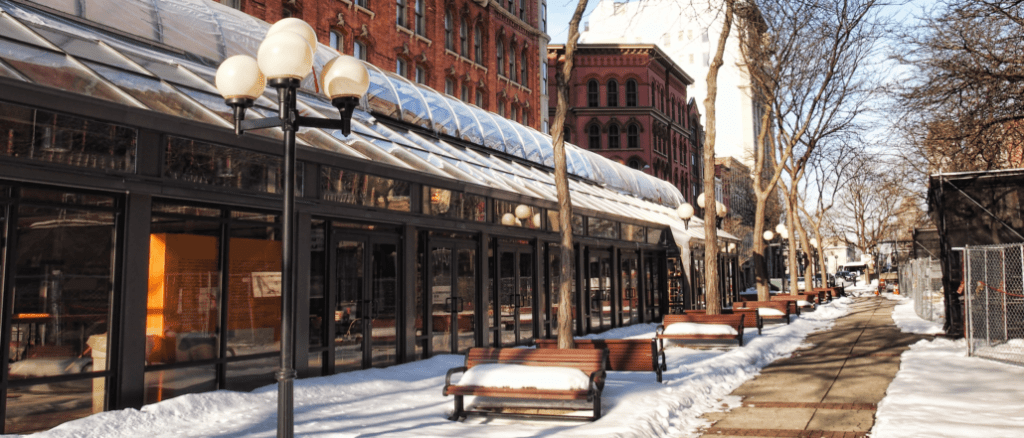Winter maintenance: How to keep your small business safe from the worst of winter weather

4 minute read
As any Canadian knows first-hand, winters in the Great White North are some of the harshest in the world. From extreme cold, to heavy snowfall, high winds, freezing rain, sleet, blizzards and ice storms, Canadians have to be ready for whatever Mother Nature throws our way.
But if you own or lease your own small business, it also means you need to protect your personnel and your property. An icy walkway could lead to a slip-and-fall injury, or an ice jam on the roof could lead to costly water damage.
As a business owner, do you know what your responsibilities are — and what you could be held liable for—when it comes to winter maintenance? It all starts with putting a documented business maintenance program in place, which should include roofs, walkways, driveways, and parking lots, as well as emergency exits.
Keep your roof clear of snow and ice
Your roof can handle a certain amount of snow and ice. But large amounts of snow, particularly wet snow, add a lot of weight to your roof — literally thousands of pounds — especially if the roof doesn’t have much of a slope. Too much extra weight can cause sagging, leaks, structural damage, or even a collapse.
Freezing rain or an ice storm can also lead to a buildup of ice on your roof — and ice is even heavier than snow. But when precipitation freezes, melts, and then freezes again, it can result in ice dams along the edge of the roof, which prevents snowmelt from draining properly.
Clearing snow and ice from your roof is dangerous work. It comes with the risk of falling from a high height, as well as the risk of electrocution (electrical wires that come into contact with moisture could cause shorts and spark fires).
That’s why it’s a good idea to call a qualified snow and ice removal professional (just make sure to ask for their proof of insurance). Even better, sign a contract with a qualified company to remove accumulated snow and ice from your roof throughout the winter season.
If, however, you choose to do the job yourself, be sure to eliminate, limit, or control any potential hazards — such as avoiding any electrical installations. Also:
Use a wood or plastic shovel to remove snow and stop shoveling before hitting the finished surface of the roof to avoid damaging it.
If there’s ice, it may be tempting to take an axe to it, but that could cause unintentional damage. Instead, use a rubber mallet to break up the ice.
Avoid using excessive heat (such as welding torches), and road de-icing salt, as that could accelerate corrosion of any metal components. Instead, a better alternative to use is roof ice melt tablets.
Take necessary measures to ensure the safety of people walking near the building during snow removal operations. A safety perimeter is recommended to keep people at a safe distance.
If you notice any cracks on the interior or exterior walls, buckling on the ceiling, door jams against the frame, and/or loud, creaking noises, evacuate the building and consult a roofing contractor to see if the roof is in danger of caving in.
Clear walkways, driveways, and parking lots
When outdoor areas such as walkways, driveways, and parking lots are icy and slippery, it could lead to a slip-and-fall injury or fender bender on your property — and that could lead to a lawsuit. That’s why it’s important to have a documented business maintenance plan for these areas, as well as emergency exits, outdoor stairs, and doorways.
If you have a service agreement with a contractor to remove snow and ice throughout the winter season, make sure the contract specifies the work to be done — and what each party is responsible for. Be sure to ask for a certificate of insurance from the contractor, and talk to your broker to confirm whether the contractor’s insurance has suitable legal liability coverage.
If you or one of your employees is responsible for snow removal, make sure there’s clear documentation on which areas need to be maintained, how often those areas should be serviced, and which equipment is required to do the job properly. Also, snow removal should be done before you open for the day to protect employees, customers, and other visitors.
Most importantly, keep a log of what has been done, at what time, and by whom. Documentation of your winter maintenance program could end up being evidence if you have to defend a claim in court resulting from a slip-and-fall.
If an incident occurs, the complainant (or witness) will need to fill out an incident report. The form should include all relevant details (including photos, if possible), as well as the date, contact information, and signature of a manager. Keep this documentation for a minimum of two years.
Your winter maintenance program should also ensure that:
Streets, yards, and routes designated for the fire department are always kept in good condition so that they can be used at any time by fire department vehicles.
Any private hydrants or fire department connections are free and clear of snow, to facilitate firefighter’s work and reduce delays.
Any natural gas inlets are in proper working order, and are free and clear of snow, bushes, plants, ice, and other materials.
With a bit of preparation and a regular winter maintenance schedule, you can mitigate risk and protect your small business from whatever Mother Nature throws your way.
Protect your business with a tailored insurance policy
You can’t always control what happens to your business, especially when it comes to things like the weather. You can, however, control how prepared your business is. Having the right protection in place can make a huge difference. Find out how TruShield can help by visiting our business insurance page today.
This blog is provided for information only and is not a substitute for professional advice. We make no representations or warranties regarding the accuracy or completeness of the information and will not be responsible for any loss arising out of reliance on the information.






